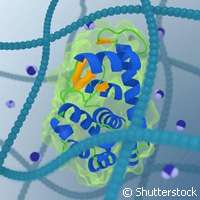Cell viscosity research improves our knowledge of cancer cells

EU-funded researchers from Germany and Poland have made some groundbreaking discoveries about cell cytoplasm viscosity, which could further our knowledge of the cytoplasm of cancer cells.
Led by researchers from the Institute of Physical Chemistry of the Polish Academy of Sciences (IPC PAS), the team was supported in part by an Innovative Economy grant from the European Regional Development Fund (ERDF).
Viscosity is a measure of a fluid's resistance or thickness. The less viscous the fluid is, the greater the fluidity or ease of movement there is within it. Water, for example, has a low viscosity, while honey, being altogether thicker and gloopier, has a higher viscosity.
It was Albert Einstein who first addressed the viscosity of complex fluids in 1906, and since then much research has been carried out into cell cytoplasm viscosity.
Over the years, a body of evidence has been built up, indicating that despite a high cytoplasm viscosity (resulting in theoretically low ease of movement within the cytoplasm), the mobility of small proteins in the cytoplasm is in fact very high - several magnitudes higher than Einstein's formula indicated.
In their study, published in the journal Nano Letters, the team investigates how small protein molecules almost do not experience this cytoplasm viscosity while moving around in the cell. They describe the changes in viscosity as measured in various solutions and experienced by probes, varying in size from a nano to a macro scale.
"We improved our earlier formulae and conclusions to successfully apply them to a larger number of systems, including the first description of the cytoplasm viscosity in cancer cells," comments Professor Robert Holyst from the IPC PAS.
The team were able to describe the viscosity changes using one phenomenological formula containing coefficients of the same physical nature. The coefficients give a description for both the fluid medium (filled with a network of long-chained polymers or clusters of molecules, for example) and what kind of probe (e.g. a protein molecule) is moving in the medium.
The new formula can then be used for probes from a fraction of nanometre up to several centimetres in size.
The relationships found were generally valid for various types of fluids including solutions with an elastic microscopic structure (e.g. polymer networks in various solvents) and microscopically rigid systems (e.g. composed of elongated aggregates of molecules - micelles).
The team also applied these new formulae to describe the mobility of DNA fragments and other probes in mouse muscle cells as well as human cancer cells "We managed to show that the fluid viscosity in the cell depends actually not only on the intracellular structure but also on the size of the probe used in viscosity measurement,' says Tomasz Kalwarczyk, a PhD student from the IPC PAS. 'Our research resulted in a novel method to characterise cell structure - by measuring the viscosity of the cytoplasm."
The implications of this research are far reaching. Scientists can now better estimate the migration time of drugs introduced in cells, and this knowledge can also be applied to nanotechnologies, for example in the fabrication of nanoparticles with micellar solutions.
The findings of the study will also have an impact on advanced measurement methods such as dynamic light scattering, which allows suspensions of molecules to be analyzed by size.
More information: Kalwarczyk, T., (2011) Comparative Analysis of Viscosity of Complex Liquids and Cytoplasm of Mammalian Cells at the Nanoscale. Nano Lett. 11, 2157-2163. DOI:10.1021/nl2008218
Provided by CORDIS
















